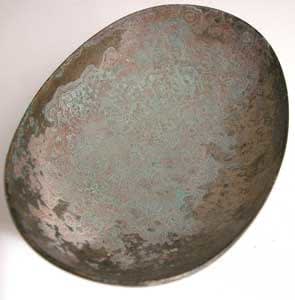Sassanian Oval Dish, 200 CE - 600 CE
Metal Alloy
6.75 x 1.75
FZ.275
Further images
In 244 A.D., Ardeshir I founded the Sassanid Dynasty, the last native Persian Kingdom to rule Ancient Iran before the Islamic conquest. The Sassanid era was a golden age of...
In 244 A.D., Ardeshir I founded the Sassanid Dynasty, the last native Persian Kingdom to rule Ancient Iran before the Islamic conquest. The Sassanid era was a golden age of Persian culture that witnessed the revival of Zoroastrianism, an ancient mystical religion native to these lands, and a literary Renaissance spurred by the translation of many Old Persian epics recorded in cuneiform into the Middle Persian language of Pahlavi written in an alphabet derived from Aramaic. By introducing heightened international trade and commerce they created a legacy of political and economic diplomacy. They sponsored trade with the Romans (later on the Byzantines), their archenemy, to the west and the Chinese to the east. Excavations in China have unearthed gold and silver Sassanid coins covering a span of many centuries until the demise of the Empire during the reign of Khosrow II. However, the fall of the Empire had already started with a series of wars waged under the rule of Khosrow I, the father of Khosrow II. Challenged by the intensification of the same international commerce that had bore such wealth, struggles for national power and international prestige had escalated to an ungovernable degree. In the face of threats to his royal house, Khosrow II embarked upon military campaigns that would prove unsuccessful. By the close of his reign, the once mighty Sassanid Empire came to an end, paving the way for the rise of Islam in the Middle East.
Made from a special alloy of metals, the intrinsic beauty of this bowl transcends both time and space. The distinct simplicity of its design gives it a universal attraction, appealing at once to all who have beheld it throughout the ages. Clearly, its preferential placement in a modern-day setting would enhance the surroundings and emote feelings of awe from its viewers.
Made from a special alloy of metals, the intrinsic beauty of this bowl transcends both time and space. The distinct simplicity of its design gives it a universal attraction, appealing at once to all who have beheld it throughout the ages. Clearly, its preferential placement in a modern-day setting would enhance the surroundings and emote feelings of awe from its viewers.





